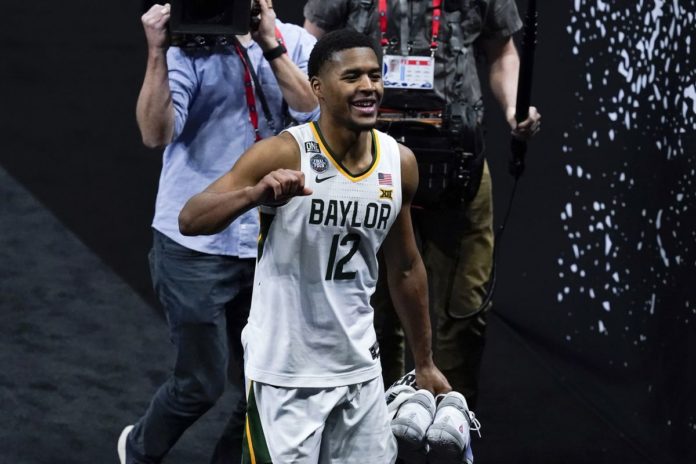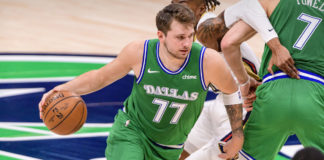The Utah Jazz were never going to have a big, splashy, extravagant offseason. This summer wasn’t about stars for the Jazz — it was about role players and working the edges of the roster.
The Jazz left the 2021 playoffs with some clearly defined issues that needed to be addressed, such as lack of versatility, defense on the wing, depth.
So how did the Jazz fare? Did they get better?
“We had a plan that we set out to try to accomplish and I think we’ve done that,” Jazz general manager Justin Zanik said. “I think that we’re giving ourselves the chance to be better.”
The Jazz started the offseason by trading away Derrick Favors and drafting Baylor guard Jared Butler. The Jazz saved a lot of money and left the door open for a more versatile front-court lineup by saying goodbye to Favors, and if Butler can be NBA-ready before the end of the 2021-22 season he could provide some much-needed depth as a reserve ballhandler.
Right off the bat the Jazz’s offseason looked good with those first two moves. Favors, in his return to Utah, unfortunately didn’t add to or improve the team in the way the Jazz needed, and with the Jazz facing the luxury tax, Favors was going to cost upwards of $20 million to keep around. The cost of getting off that contract was a future first-rounder traded along with Favors to the Oklahoma City Thunder in exchange for a future second-round pick and cash considerations. The move made sense.
:no_upscale()/cdn.vox-cdn.com/uploads/chorus_asset/file/22775758/AP21093846175991.jpg)
With Butler, it’s impossible to know if he’s going to develop into a reliable and serviceable NBA player. That’s just how this works. We can speculate on the talent of a collegiate player all we want, never knowing for sure if they’ll reach the theorized potential often until years later. But after three years at Baylor, winning a national title, and his improvement over those three years, here’s what the Jazz are hoping for.
Butler is crafty, smart and good on and off the ball. When the Jazz were without their All-Star backcourt of Donovan Mitchell and Mike Conley through the home stretch of the season and then when both were injured during the playoffs, things got difficult.
Joe Ingles just simply is not able to take on all of the point guard duties and still be his most effective self. Plus, Ingles’ contract is expiring after this season and the Jazz need to plan for the future. If Butler can develop into a reliable backup point guard who is also able to play off the ball when needed (as he was able to do at Baylor) and knock down shots, then the Jazz will be in good shape.
The Jazz certainly aren’t expecting for two of their All-Stars to again be injured heading into the postseason, but the player who could potentially help them out and provide some depth was available to be drafted at 40th overall, meaning the Jazz were able to pick up future assets to trade down from 30 and get him. Another good move.
When free agency opened up, the Jazz needed to make sure that Conley didn’t go anywhere. There wasn’t much concern about Conley leaving, but getting the deal done quickly was important.
The deal was accomplished on the first day of free agency and it keeps the All-Star point guard on the roster for the next three years. Had the Jazz not re-signed Conley, they wouldn’t have been able to replace him with a player of his caliber due to not having the cap space to make it happen, so re-signing him was a no-brainer.
:no_upscale()/cdn.vox-cdn.com/uploads/chorus_asset/file/22435841/merlin_2864631.jpg)
We don’t have a crystal ball that will tell us what Conley will be capable of three years from now, and the hamstring injuries are certainly a reason to be concerned about his longevity, but Conley said he’s been working hard during the summer to make sure he’s stronger and hopefully can curb some of the injury issues he’s experienced.
“I’ve been training real hard,” he said. “I’ve been going through a really good program to try to hopefully knock out these issues that have been creeping up in the last few years.”
Conley has introduced yoga and other forms of strength training into his regiment and will be working with the Jazz’s health performance staff to do everything it can to deliver him to the postseason healthy, and that’s all you can really ask for.
Once Conley’s contract was addressed, the Jazz added Rudy Gay to the roster. The Jazz signed Gay using the $5.9 million tax-payer mid-level exception. The last time Gay made less that $6 million a year was the 2009-10 season.
Gay’s offensive production has slowly dipped over the past four years, but that came as he accepted a bench role and had the ball in his hands less.
The hallmark of Gay’s career has been his ability to adapt to a system and mold his skills to a team’s needs. When the Deseret News asked Gay during his introductory press conference what the team needs to be better, he said what everyone else has been saying for a while and it felt like he fit the bill.
“You need guys that can play multiple positions,” Gay said. “I feel like I’ve changed my game to be that. I’m a bigger guy that can play and guard multiple positions.”
Gay gives the Jazz an option at having a small-ball five who has had a long career of being a solid defender. He’s great in isolation and he’s even better on help defense and rotating and switching.
The Jazz needed some defensive depth on the perimeter and they also needed frontcourt versatility. The idea with Gay is that he can provide both of those things for the Jazz.
But the Jazz don’t just want to have Gay playing as Rudy Gobert’s backup, they wanted someone who could keep the Jazz big and protect the rim. With Udoka Azubuike still developing and needing some time to become NBA-ready, the Jazz added Hassan Whiteside on a one-year minimum contract.
:no_upscale()/cdn.vox-cdn.com/uploads/chorus_asset/file/22775764/AP21046218247611.jpg)
Whiteside was a starting center for six years until last season. He’d played big minutes in big moments for the Miami Heat and Portland Trail Blazers and then was left behind last year with the Sacramento Kings as the team opted for youth and offense over what Whiteside provides.
With the Jazz, Whiteside will not have his starting position back, but he will be able to reprise his roll as a defensive rim-running big and prove that he still has a lot to give this league.
There’s a lot that could happen here. Whiteside might not work out with the Jazz, Azubuike might create competition for the reserve center position, or it might all play out seamlessly. Either way, it was a cost-effective and low-risk move for the Jazz.
The Jazz made one more move, trading a second-round pick to the Golden State Warriors for Eric Paschall. Entering his third NBA season, who Paschall is as a player remains to be seen. He had an impressive rookie season followed by a mediocre second year, but it’s possible that the best of Paschall is yet to come. He could potentially add depth to a versatile small-ball lineup and is known for being tough and gritty in the paint.
:no_upscale()/cdn.vox-cdn.com/uploads/chorus_asset/file/22775773/AP21092859032394.jpg)
But the real value of Paschall is off the court. He and Mitchell grew up just down the street from one another, went to the same church, played AAU ball together, battled against each other in high school, share the same agent and now have a chance to play together on the biggest stage.
The Jazz can talk about development of young players and the potential they see in Paschall all they want. The truth is that it was a savvy business move, bringing in one of the best friends of a franchise player, especially at the price the Jazz were able to swing it.
So, after all that, are the Jazz better? The honest truth is that none of us will know until the final 2021-22 playoff game the Jazz play. Even then, it might take time to really know.
If we think back to what Conley looked like when he first joined the Jazz two seasons ago, it seemed like he just wasn’t going to be able to find himself and fit with the team. Now, the Jazz would be much worse off if not for Conley.
Would the Jazz look a lot better if they had just one more guy on the wing that could defend and switch easily? Yes. But those are the guys the whole league is looking for every single day, and just because the offseason comes to an end doesn’t mean the Jazz are done making moves or additions.
The Jazz added some depth and versatility to the roster this summer and they did so without disrupting their roster. They hope that formula is going to mean greater success for the team.
“A little bit of change, along with a good amount of continuity, some lessons learned, and an ability to go forward,” Zanik said of the Jazz’s offseason.
On paper, the Jazz did a good job this offseason with limited resources and they did get better. But better on paper does not always translate to the product on the court. For that, we’ll have to wait and see.








